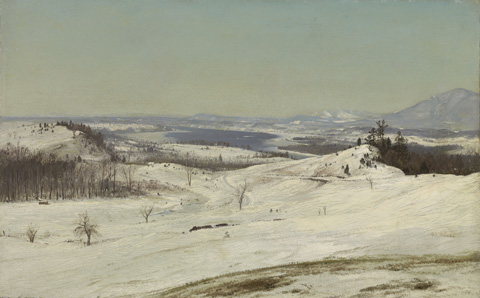
Frederick Edwin Church’s “View from Olana in the Snow,” (c. 1871). |
The Alfond-Lunder Family Pavilion at the Colby College Museum of art, just opened, has added some 66 percent to the museum’s existing exhibition space, to a total now of some 38,000 square feet. With the gift of the 500 or so objects from the Lunder Collection, it means they can fill the space without breaking into a sweat.
When you weave the Lunder gift into the existing collections — the Schupf collection of Richard Serra works on paper, the Alex Katz collection of his own work in its own wing, the Katz foundation gifts of contemporary art and many others, you have an art museum that a great many midsized cities would sell whatever soul they have remaining, in these degraded times, to possess within their boundaries. Yet there it is, in, yes, Waterville, Maine (population 16,000), some 70 miles up the Kennebec River and a good hour and a half from the nearest anyplace else.
For this inaugural exhibition the curators were faced with the enviable dilemma of too much to choose from. After all, the Lunder gift includes some 300 works by James McNeill Whistler alone, including paintings and works on paper, and has 40 or so Chinese historical funerary works that date from prehistoric times to the Jin Dynasty. They have chosen to mostly group things by theme, and in chronological order within the group, which sometimes feels odd and other times revealing.
For a casual visitor it’s a little like diving into Scrooge McDuck’s money bin, sorting out silver from copper according to taste and inclination. One gets, for instance, to avoid the tendentious Old West mythmaking of Frederick Remington and his colleagues and seek out such real gems as Charles-François Daubigny’s “River Landscape” (1860) not far from Frederick Edwin Church’s excellent oil sketch “View from Olana in the Snow,” (c. 1871).
The Augustus Saint-Gaudens sculptures are saved from their own neo-classical style by his deep sense of physicality. The wearying oh-so-perfection of the Paul Manship sculptures gives way to the comforting irregularity of the John Chamberlain wall piece “Rare Meat” (1977), made from car parts, and Deborah Butterfield’s welded steel horse, “Nahele” (1987).
Simply navigating the many Whistlers on view is a little daunting, but has its rewards. Whistler’s pure facility was tempered by not only his wit but his fundamental inquiry into the nature of art that was related to, but separate from, the imperatives driving the Impressionists. It shows in the apparent incompleteness in paintings like “Chelsea in Ice” (1864) and the print “The Pierrot” (1889). What is there resonates with what is left out, with implications that are shared by artist and viewer. There’s a good reason why Proust’s composite artist was called “Elstir.”
Some parts of the contemporary collection seem perfunctory, as if collected to have the name aboard. Neither of the Claes Oldenburg pieces, “Model for Clothespin” (1974) and “Typewriter Eraser” (1977), have much to offer except a possibly quizzical response by those young enough to not know what they are modeled on. The Donald Judd “Untitled” (1977) and the Christo print, like all his work, basically just say “I’m an artist and you’re not.” The life-size hyper-realistic sculpture of a card player by Duane Hanson from 1973 has lost its appeal as time has passed.